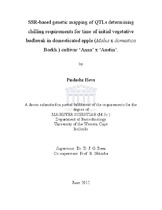| dc.description.abstract | The Rosaceae family contains major temperate crops such as the domesticated apple(Malus x domestica Borkh.), peach (Prunus persica L. Batsch) and European pear (Pyrus communis L.). However, despite its evident economic importance, it is generally poorly studied in genomic terms, relative to the other major crop groups. Microsatellite and Diversity Array Technology (DArT) genetic markers have been exploited in this work and are essential tools in genetic map construction and marker-assisted selection (MAS) of high quality apples and other rosaceous crops. Microsatellites are advantageous in that they are co-dominant, highly polymorphic, abundant, transferable and reliably reproducible; hence their use in this study. In order for budbreak to take place in a timely and homogenous fashion, apple trees need a period of exposure to low temperatures.Within orchards the application of chemicals that induce budbreak in unsuitable environments is required to produce apples from cultivars that require high chilling levels. However, this and other practices using chemicals in orchards tend to pollute the environment. One of the solutions to this problem is to breed low chill apples such as ‘Anna’ cultivar, which was used as one of the parents in this study.This work was aimed at understanding the underlying genetic factors that determine chilling requirements for the time of initial vegetative budbreak trait in the apple cross ‘Anna’ x ‘Austin’. This was achieved through linkage map construction using SSR and DArT molecular markers followed by QTL analysis. This thesis has therefore exploited the large number of Expressed Sequence Tags (ESTs) and genome sequence data for the apple, using Tandem Repeats Finder, to design a total of 98 new SSR primers pairs. The other 369 SSR markers used in this work were from published work. JoinMap! 4.1 software was used to create an integrated genetic map with 17 linkage groups, for the
domesticated apple cultivar, ‘Austin’ x ‘Anna’ mapping population with 80 individuals.The result of this process was a genetic map 1 212cM in length, and a total of 429 markers (314 DArT and 115 SSR), at an average density of a marker every 4 cM. This map was used identify the Quantitative Trait Loci (QTLs) determining chilling requirements for time of vegetative budbreak (IVB). In this process, putative IVB QTLs were identified in the ‘Anna’ x ‘Austin’ mapping population using the rMQM analysis function of MapQTL! 6.0, for both adult and seedling data collected over 3 growing seasons from 1996 to 1998. These QTLs were detected on linkage groups 2, 9 and 14,and explained 0.3 to 12.8 % of the observed phenotypic variation for the adult population,and 5.3 - 21 % for the seedling population. Seedling (LG 14) and adult (LGs 5, 7, 10)
specific QTLs were also detected for the ‘Anna’ x ‘Austin’ cross. These QTLs will provide the basis for marker validation on related mapping populations in the apple breeding programme, and for the future identification of candidate genes controlling the process of budbreak. | en_US |

